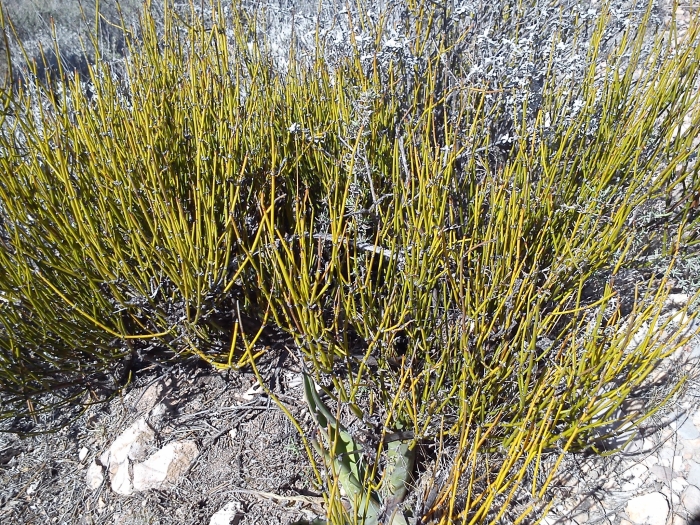Mormon Tea
(Ephedra antisyphilitica)
Mormon Tea (Ephedra antisyphilitica)
/
/

Tereso Hernández Morales
CC BY 4.0
Image By:
Tereso Hernández Morales
Recorded By:
Copyright:
CC BY 4.0
Copyright Notice:
Photo by: Tereso Hernández Morales | License Type: CC BY 4.0 | License URL: http://creativecommons.org/licenses/by/4.0/ | Rights Holder: Tereso Hernández Morales | Publisher: iNaturalist | Date Created: 2016-02-25T10:13:25-08:00 |

















































Estimated Native Range
Summary
Ephedra antisyphilitica, commonly known as Mormon Tea, is an evergreen shrub native to arid and semi-arid regions, particularly the Chihuahuan Desert and other desert areas in the southern Great Plains of the United States (Oklahoma, New Mexico, Texas), as well as northeastern Mexico. It typically grows to a height of 3-4 feet (0.9-1.2 meters) and a width of 3-6 feet (0.9-1.8 meters). This plant is characterized by its jointed green stems, reduced leaves, and inconspicuous yellow cones that serve as flowers, which are not particularly showy but are interesting botanical features.
Mormon Tea is valued for its drought tolerance and its ability to thrive in harsh desert environments, making it a suitable choice for xeriscaping and low-water-use gardens. It is often used in rock gardens, as a ground cover, or in naturalistic plantings. Mormon Tea requires minimal maintenance and is adapted to full sun exposure and well-drained soils, preferring sandy or rocky substrates. It is not known for having serious disease or pest issues, but gardeners should be aware that it may not tolerate overwatering or heavy, poorly drained soils. This plant has a history of medicinal use by indigenous peoples and settlers, although it should be used with caution as ephedra contains compounds that can affect heart rate and blood pressure.CC BY-SA 4.0
Mormon Tea is valued for its drought tolerance and its ability to thrive in harsh desert environments, making it a suitable choice for xeriscaping and low-water-use gardens. It is often used in rock gardens, as a ground cover, or in naturalistic plantings. Mormon Tea requires minimal maintenance and is adapted to full sun exposure and well-drained soils, preferring sandy or rocky substrates. It is not known for having serious disease or pest issues, but gardeners should be aware that it may not tolerate overwatering or heavy, poorly drained soils. This plant has a history of medicinal use by indigenous peoples and settlers, although it should be used with caution as ephedra contains compounds that can affect heart rate and blood pressure.CC BY-SA 4.0
Plant Description
- Plant Type: Shrub
- Height: 3-4 feet
- Width: 3-6 feet
- Growth Rate: Moderate
- Flower Color: N/A
- Flowering Season: Non-Flowering
- Leaf Retention: Evergreen
Growth Requirements
- Sun: Full Sun
- Water: Low
- Drainage: Medium, Fast
Common Uses
Drought Tolerant, Low Maintenance, Potted Plant
Natural Habitat
Arid and semi-arid regions, particularly the Chihuahuan Desert and other desert areas
Other Names
Common Names: Clapweed, Ephedra, Erect Ephedra, Clap-Weed, Popote
Scientific Names: , Ephedra antisyphilitica, Ephedra antisyphilitica var. brachycarpa, Ephedra texana, Ephedra antisyphilitica subsp. brachycarpa, Ephedra occidentalis,
GBIF Accepted Name: Ephedra antisyphilitica Berland. ex C.A.Mey.